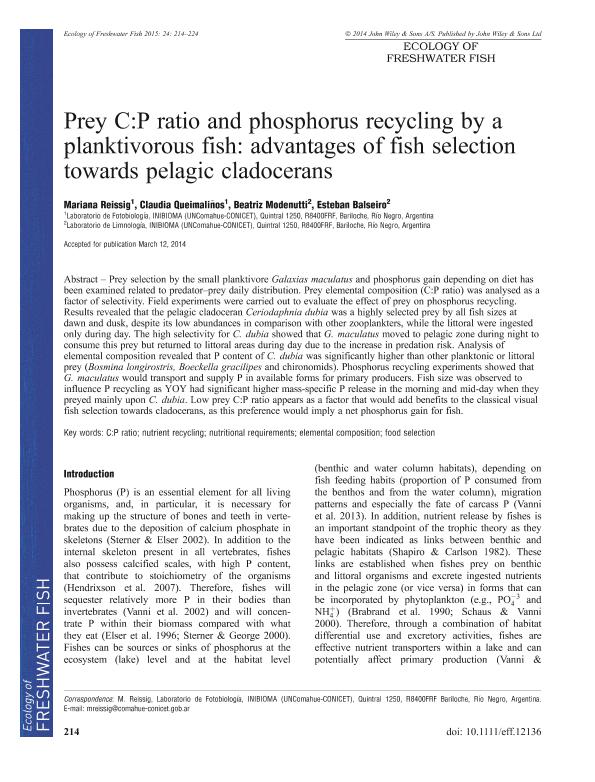Mostrar el registro sencillo del ítem
dc.contributor.author
Reissig, Mariana

dc.contributor.author
Queimaliños, Claudia Patricia

dc.contributor.author
Modenutti, Beatriz Estela

dc.contributor.author
Balseiro, Esteban Gabriel

dc.date.available
2017-01-27T21:31:34Z
dc.date.issued
2015-04
dc.identifier.citation
Reissig, Mariana; Queimaliños, Claudia Patricia; Modenutti, Beatriz Estela; Balseiro, Esteban Gabriel; Prey C:P ratio and phosphorus recycling by a planktivorous fish: advantages of fish selection towards pelagic cladocerans; Wiley; Ecology Of Freshwater Fish; 24; 2; 4-2015; 214-224
dc.identifier.uri
http://hdl.handle.net/11336/12148
dc.description.abstract
Prey selection by the small planktivore Galaxias maculatus and phosphorus gain depending on diet has been examined related to predator–prey daily distribution. Prey elemental composition (C:P ratio) was analysed as a factor of selectivity. Field experiments were carried out to evaluate the effect of prey on phosphorus recycling. Results revealed that the pelagic cladoceran Ceriodaphnia dubia was a highly selected prey by all fish sizes at dawn and dusk, despite its low abundances in comparison with other zooplankters, while the littoral were ingested only during day. The high selectivity for C. dubia showed that G. maculatus moved to pelagic zone during night to consume this prey but returned to littoral areas during day due to the increase in predation risk. Analysis of elemental composition revealed that P content of C. dubia was significantly higher than other planktonic or littoral prey (Bosmina longirostris, Boeckella gracilipes and chironomids). Phosphorus recycling experiments showed that G. maculatus would transport and supply P in available forms for primary producers. Fish size was observed to influence P recycling as YOY had significant higher mass-specific P release in the morning and mid-day when they preyed mainly upon C. dubia. Low prey C:P ratio appears as a factor that would add benefits to the classical visual fish selection towards cladocerans, as this preference would imply a net phosphorus gain for fish.
dc.format
application/pdf
dc.language.iso
eng
dc.publisher
Wiley

dc.rights
info:eu-repo/semantics/openAccess
dc.rights.uri
https://creativecommons.org/licenses/by-nc-sa/2.5/ar/
dc.subject
C:P Ratio
dc.subject
Nutrient Recycling
dc.subject
Nutritional Requirements
dc.subject
Elemental Composition
dc.subject
Food Selection
dc.subject.classification
Ecología

dc.subject.classification
Ciencias Biológicas

dc.subject.classification
CIENCIAS NATURALES Y EXACTAS

dc.title
Prey C:P ratio and phosphorus recycling by a planktivorous fish: advantages of fish selection towards pelagic cladocerans
dc.type
info:eu-repo/semantics/article
dc.type
info:ar-repo/semantics/artículo
dc.type
info:eu-repo/semantics/publishedVersion
dc.date.updated
2016-12-12T14:28:50Z
dc.identifier.eissn
1600-0633
dc.journal.volume
24
dc.journal.number
2
dc.journal.pagination
214-224
dc.journal.pais
Estados Unidos

dc.journal.ciudad
Hoboken
dc.description.fil
Fil: Reissig, Mariana. Universidad Nacional del Comahue. Centro Regional Universitario Bariloche. Laboratorio de Fotobiologia; Argentina. Consejo Nacional de Investigaciones Científicas y Técnicas. Centro Científico Tecnológico Patagonia Norte. Instituto de Investigación en Biodiversidad y Medioambiente; Argentina
dc.description.fil
Fil: Queimaliños, Claudia Patricia. Universidad Nacional del Comahue. Centro Regional Universitario Bariloche. Laboratorio de Fotobiologia; Argentina. Consejo Nacional de Investigaciones Científicas y Técnicas. Centro Científico Tecnológico Patagonia Norte. Instituto de Investigación en Biodiversidad y Medioambiente; Argentina
dc.description.fil
Fil: Modenutti, Beatriz Estela. Universidad Nacional del Comahue. Centro Regional Universitario Bariloche. Laboratorio de Limnologia; Argentina. Consejo Nacional de Investigaciones Científicas y Técnicas. Centro Científico Tecnológico Patagonia Norte. Instituto de Investigación en Biodiversidad y Medioambiente; Argentina
dc.description.fil
Fil: Balseiro, Esteban Gabriel. Universidad Nacional del Comahue. Centro Regional Universitario Bariloche. Laboratorio de Limnologia; Argentina. Consejo Nacional de Investigaciones Científicas y Técnicas. Centro Científico Tecnológico Patagonia Norte. Instituto de Investigación en Biodiversidad y Medioambiente; Argentina
dc.journal.title
Ecology Of Freshwater Fish

dc.relation.alternativeid
info:eu-repo/semantics/altIdentifier/doi/http://dx.doi.org/10.1111/eff.12136
dc.relation.alternativeid
info:eu-repo/semantics/altIdentifier/url/http://onlinelibrary.wiley.com/doi/10.1111/eff.12136/abstract
Archivos asociados
